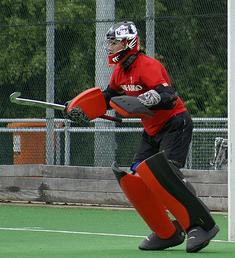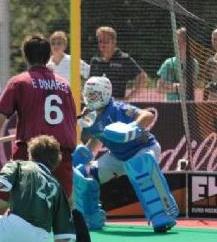An important feature of your ready stance is your glove positioning. If you keep your hands low and inactive, out of the way where they can only block low, you make them effectively useless; taking them out of action for a raised save. However, by bringing them up, where you can then be able to move with greater reaction to counter act the speed of the shot. As raised drag flicks are virtually unstoppable when roofed into the top corners, it is important to try and combat this. With your gloves in front of your body, you do not have to bring the arm up on the save; this makes it easy to get your glove on saves to control the shot and rebounds, rather than missing the shot entirely.
A raised glove stance is a technique used by soccer and ice hockey goalies to maximise shot stopping abilities by ‘being set’ before the shot, and works just as well when applied to hockey. The theory behind it is that with your gloves already ready; in position for the immediate save, you do not have to move as much on reacting to the shot. The closer you are to the ball, the less you have to react to the shot, due to forward preparation. It makes life easier shot stopping as you close down the shooter’s options, speeding up your reaction to the shot as you have more time to react by being nearer the incoming ball.
Being pro-active with your stance, you can actively challenge the shooter; covering space and limiting their shooting options. Mentally and physically ready for the shot, you are set before the play more able to deal with the impending strike.
Hands tight to the body
There is a tendency to routinely forget or ignore a proper ready stance, and be lazy in positioning your gloves, simply letting them drop to your sides. Limiting yourself in your ability to save shots by being held back against the incoming shot is not good: against a fast strike, you cannot react in time to stop it properly. The further your gloves are from the ball, the harder the save is; reacting late to the shot as it comes in and requiring you to lift your arms up high within an instant, whilst covering less space (so the shooter can see more of the goal, and you cannot close off options).
With your hands ‘back’ and close to your body, you are limiting your ability to make saves. There is also the possibility of interference, with your arms rubbing and bashing into your body, as you lock them into your stance, which can prevent full range of movement. Trying to be over reliant on reflexes is a bad idea – you simply cannot stop high shots with a low glove position. You can make the best use of your reflexes by having your hands already up for the save; increasing your reaction speeds against the shot and therefore reacting immediately, gaining the edge needed to stop the ball.
Gloves out
With your gloves out in front of you, you can get behind the save more easily; with more power and speed. Logically, you are closer to the ball on the raised shot: the closer you are, the less you have to react (as you are already in position for the save) and can therefore reduce reaction times for a fast reflex save against screened shots or quick shots. By pushing out with strong momentum, and less distance to travel to meet the ball, you can power into the save and force the rebound away further, with the momentum.
In contrast, to a stance with your gloves placed down by your sides, you can be more flexible and active with your hands out, getting your gloves on every shot that comes your way; pro-actively reacting to shots, with greater movement and fluidity, rather than trying to push into saves outside your comfort zone (if playing a tighter stance). With your hands out in front of your body, you have less work to do, enabling you to react quicker with greater aptitude.
Against drag flicks, with great height and speed (i.e. crossbar height), it is impossible to bring your gloves up high enough from a low starting position to reach into a raised save; therefore, by having the gloves up and out in the space, you stand a better chance of reaching the ball on time.

Gravity works the same way, so it is easier to drop your gloves for a lower save, as you can quickly bring your glove down, facing the ball, to build up a blocking barrier (if needs be around the hip), when dealing with a shot around the body. If you face a lower shot than expected within this position, then you can simply bring your gloves down; reacting to the danger as it presents itself and blocking instinctively.
Pointers:
-
Hold your gloves out in front of you (about the third of a stick length or more) to move them away from your body
-
Try to get your gloves to shoulder or chest height to bring them up for higher shots
-
Have your elbows outside your body (bringing the arms out to the side so they are horizontal), so they do not interfere, and free up the range of available movement
-
With both hands out, you can be active with your rhp as well – don’t always try to bring your glove across, if you can make the block with your rhp
Working on strengthening your arms will help you in being able to hold your gloves out in your stance (without getting tired and then lazy) for the full length of the game, especially if you use a heavy stick – weight training (for keepers aged 16 and over) can be helpful with this. Wrist weights on the hands also be useful in building up resistance on glove positioning.
Fransisco Cortes of Club Egara (current Spanish number 1 keeper) is a great example to watch and learn from; he has a ready stance with his gloves far forward, consistently positioning all the time, in every game situation, in order to be active with his glove saves. You can watch highlights of him in action at the Euro Hockey league website , or search for “Spain hockey” or “Club Egara” on YouTube. Vogels (the well known Dutch no. 1) also uses the same glove positioning, out in front of his body (search for “Netherlands hockey”, “HGC”, or “Hoofdklasse” on YouTube to watch him in action).

Be active
The key to having your gloves out for saves, is making it become a standard thing. To make sure you are doing it, you have to programme your mind to get set in the same stance all the time. Train yourself to get into a proper hand stance every time you set for the shot, so that it becomes automatic during games. In training purposefully practise with your gloves out on all shots; this will then transfer into games where you will find yourself automatically pushing your gloves out.
Ultimately, it is up to the individual to decide how you position your gloves, but having the gloves out does improve the ability to stop shots around you, with greater capability. It is not being passive, but the opposite; you are quicker moving into the save than when trying to push out from a tight stance, with the gloves close into the body, taking advantage of reaction times on really fast shots, to give yourself the best fighting chance of a save.